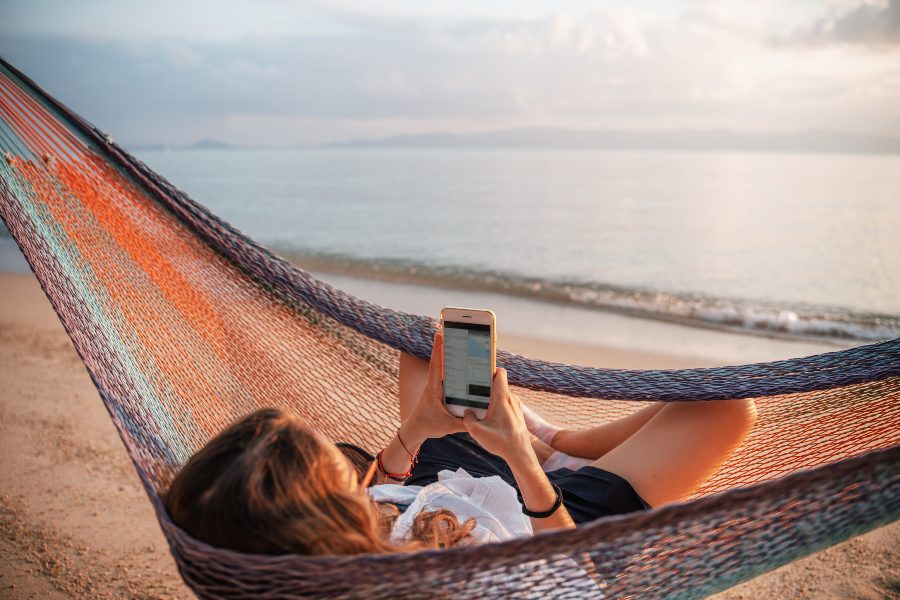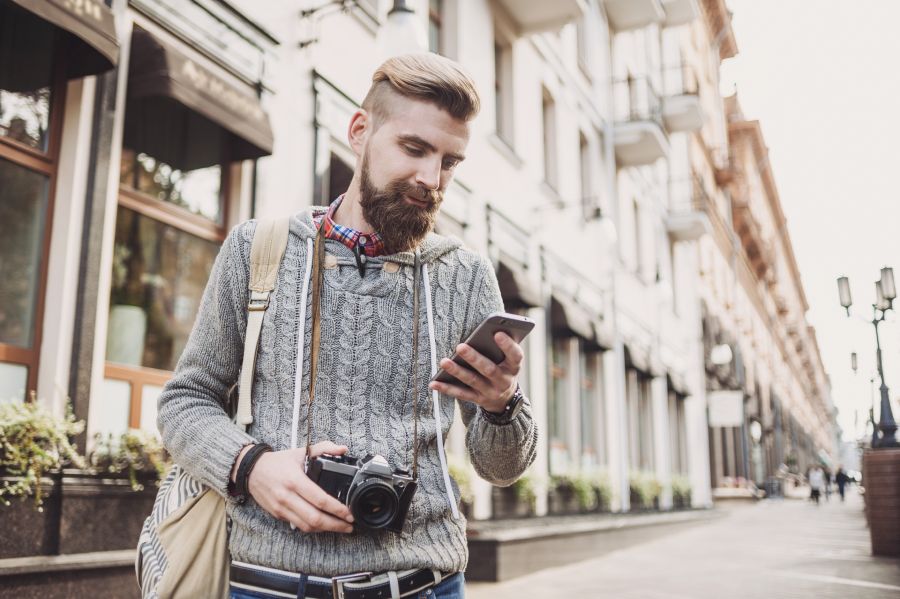Email is the best way to communicate with your guests. Whenever they make a booking, they expect to hear from you in their inbox. It’s the one channel they turn to for confirming payment and getting more information. If they don’t receive anything, they often feel confused, uncertain, and forgotten, which is not a great first impression.
But perhaps you gravitate to speaking with them over the phone because you like that human presence. Or maybe you’re not quite sure how to write a guest email in the first place. Instead of shying away from this method of communication, however, it’s best to jump on board with what your guests prefer. And nowadays, that’s email.
In this article, I’ll go over the five types of booking emails you should send before and after check-in. And if writing isn’t your strong suit, I’ve also created free email templates you can borrow to stay in contact with your guests. Let’s get started!
1. Confirmation Email
A confirmation email confirms a guest has successfully booked and, if applicable, paid in full or submitted a deposit for the experience. You should send it immediately after a guest completes the booking and payment process, or whenever a change has been made to the booking.
Booking an experience is a big deal. There’s usually a reason behind it, whether it’s for a bachelorette party, family outing, or to cross something off a bucket list. Knowing how to write a booking confirmation email that’s useful can give your guests peace of mind that their payment was accepted and they’re 100% booked.
Best Practices
Cover the essentials
A confirmation email isn’t just for verifying booking and payment. It also allows your guests to double-check that everything is correct. Here’s what you should include:
- Invoice
- Date & Time
- Product name
- Number of guests
- Location
- Cancellation & refund policy
Hype up the experience
Sure, you can simply confirm the booking, but where’s the fun in that? Your guests just booked a unique experience! Reaffirm that they made the right choice by giving them a reason to be excited. For example, you can say something in the subject line that emphasizes what they’re going to do — like, “You’re Booked to Make an Elephant Friend!”
Provide the next steps
Is there anything you need your guests to do before they arrive? Like, sign a liability waiver? Or fill out details for every guest in the group? This is your chance to be clear about what you require ahead of time and how they can carry out those tasks. You can also give them a heads up to expect more emails before check-in.
Reward them for booking
Saying thank you is a great start, but you can take it to the next level by rewarding them with a small discount. Everyone loves surprises. Your guests will feel appreciated and might put it towards another experience or merchandise to take home as a souvenir. If you can’t do this, consider offering an incentive to book over a dollar amount instead.

2. Reminder Email
A reminder email does what the name suggests. The purpose is to remind a guest of their upcoming booking one to two days before the experience.
Sometimes people neglect to slate an event in their calendar, overschedule themselves, or simply forget. Help prevent no-shows by sending them a friendly reminder so that they don’t miss out or can cancel if they need to. You can also use it as an opportunity to remind them to fill out the proper online paperwork if they haven’t yet.
Best Practices
Confirm the details
Guests who book months in advance may need a little refresher about what they’re doing, where they need to go, and when they need to be there. Go over the details again so they have all the information they need to show up at the right place and time.
Give them directions
Google Maps is a saving grace, but some of your guests may not have cellphone data in your country, or your meeting spot might be too obscure. The last thing you want is for your guests to get lost trying to get there. So give them clear and precise directions for all modes of transportation, using the airport or city hub as the starting point.
Answer their questions
Think about the questions your guests might have that’s causing them to worry and stress. Like, what do they need to bring? What can they do with their personal belongings? How early should they arrive? Answering these questions in the reminder email, or linking to your FAQ page, can prevent confusion and help them come prepared.
Add value to their day
At this point, your guests should have a better idea of what the weather will be like, how much wiggle room they have in their budget, and whether there’s any free time in their itinerary. Use the opportunity to introduce them to another experience you offer that can make their trip even better. They just might have “vacation brain” to go all out.

3. Thank-You Email
This email is like a short and sweet thank you for booking with us message that comes immediately after the experience while bidding adieu with a “hope to see you again!”
Gratitude continues a positive experience for your guests after check-out. By taking the time to thank your guests, they feel valued and acknowledged for booking with you, which in turn solidifies a long-term relationship, motivates them to spread the word, improves your brand reputation, and sets you apart from the competition.
Best Practices
Say more than thanks
Your guests already get so many thank-you emails from other brands. If all you say is “Thank You” in the subject line, they’ll skip right over it. To stand out in their inbox, bring up something relevant to the experience that they’ll recognize right away, such as:
- [First name], thanks for helping us spot whales!
- Thanks for hunting ghosts with us, [first name]!
- Thanks for trying Malaysian cuisine, [first name]!
Personalize the message
You can use personalization tokens here, but it’s also a good idea to tailor the message to each of your different products. Instead of writing a generic thank-you across the board, highlight a wow moment that happens rain or shine. This will help reignite those warm fuzzy feelings they had at the time, priming them for a review.
Show your appreciation
It’s one thing to say thank you, and another to show your appreciation with a small discount, or even better, free photos! If you take pictures of the experience, your thank-you email is the perfect time to provide guests with photo proof of their good time, giving them something to commemorate the experience and share on social media.
Leave it open-ended
A thank-you message doesn’t have to be the last stop. There are many other actions your guests can take that’ll keep them engaged long after the experience. You can turn them into subscribers by telling them about your newsletter, get bookings from their friends by mentioning your referral program or gain their loyalty by sharing your social accounts.

4. Follow-Up Email
A follow-up email asks a guest for feedback as a way to follow up with them after the experience. It’s typically sent two days after check-out so that they have enough time to process the experience, but it’s still fresh in their minds.
Your guests have the best insight into what you should do more of and where there’s an opportunity to improve. By asking for their feedback, you show that you value their opinion, which can help them feel important and involved in making the experience even better for the next person or if they book again one day.
Best Practices
Send a survey
The best way to ask for guest feedback is with a survey. Sometimes, your guests might not know what to say or have time to craft a thoughtful response, especially if they’re still busy enjoying their vacation. By prompting them with questions instead, you can make it quick and easy to share what they thought about the experience.
Share the time estimate
When people see the word survey, their first reaction is usually, “how long will this take?” You already know that there are only a few questions, but they don’t. Rather than leave them to assume they don’t have time, tell them it will only take a couple of minutes.
Measure the results
The number one reason you should send a survey is that it allows you to get a quantifiable measurement of guest happiness. Using either the Customer Satisfaction Score or Net Promoter Score, you can track your company’s performance over time, like whether you’re meeting guest expectations or increasing word-of-mouth marketing.
End with a review prompt
Writing an online review is a natural next step for guests who just shared their feedback. By ending the follow-up email with a CTA that takes them to your preferred review site, you can get more reviews. Depending on the online survey tool you use, you might even be able to toggle this on or off based on the score so that you only prompt happy guests.

5. Cancellation Email
A cancellation email confirms a guest has cancelled the booking and received a refund.
Like the confirmation email, guests want to make sure that their cancellation went through successfully and got their money back. Cancellations happen. Guests churn. Plans fall through sometimes. If you handle the cancellation gracefully, they can still walk away with a positive experience or even change their mind.
Best Practices
Provide visual proof
Remember including an invoice for the confirmation email? Well, you’ll want to send the invoice again to show that you issued a full or partial refund, depending on your cancellation and refund policy. It’s also a good idea to include the word “Cancelled” in the subject line so that they see it in their inbox right away for peace of mind.
Offer an incentive
A cancellation email might be your last shot to turn things around. Sometimes, you can reel them back in by offering a small discount or earn a referral by giving them a coupon code to share with someone else. Just because they may not be able to make it work for their itinerary, it doesn’t mean their family, friends, or travel companions can’t.
Suggest an alternative
There are many reasons why guests might cancel. They can get hyped about an experience and start to feel anxious as the day creeps closer. Or something else can pop up on their calendar that conflicts with the date and time. Whatever the case may be, let them know about a different experience or other days with availability.
Keep them engaged
Maybe they don’t want to book with you right now, but that doesn’t mean they won’t want to in the future. Suppose you have a downloadable guide. In that case, you can show them you still care about their visit by offering them free travel advice while nurturing them to reconsider your experiences for their trip in a nurture campaign.
Final thoughts
There are many other benefits to email marketing for tourism beyond excellent customer service. It can help you nurture prospects. Turn missed opportunities into bookings. And, best of all, keep your brand top of mind. You just have to know how to stand out in an inbox, provide value beyond pushy sales tactics, and provide an explicit action to take.

Take your business to the next level
Online bookings. Flexible pricing. Outstanding support.



